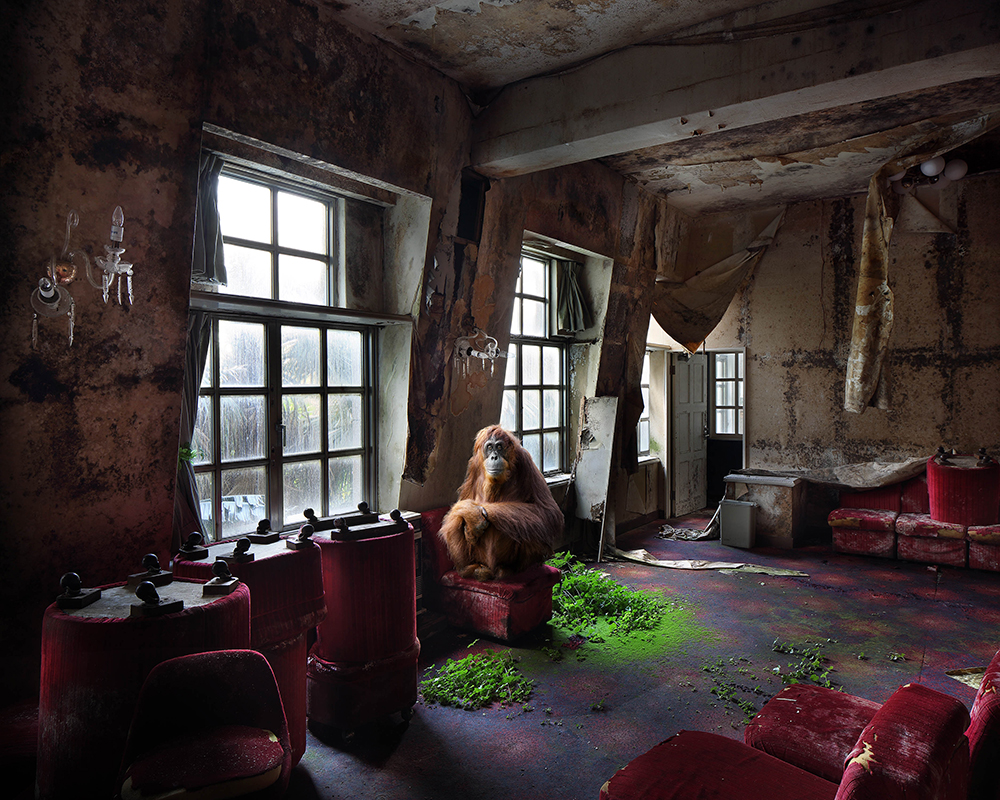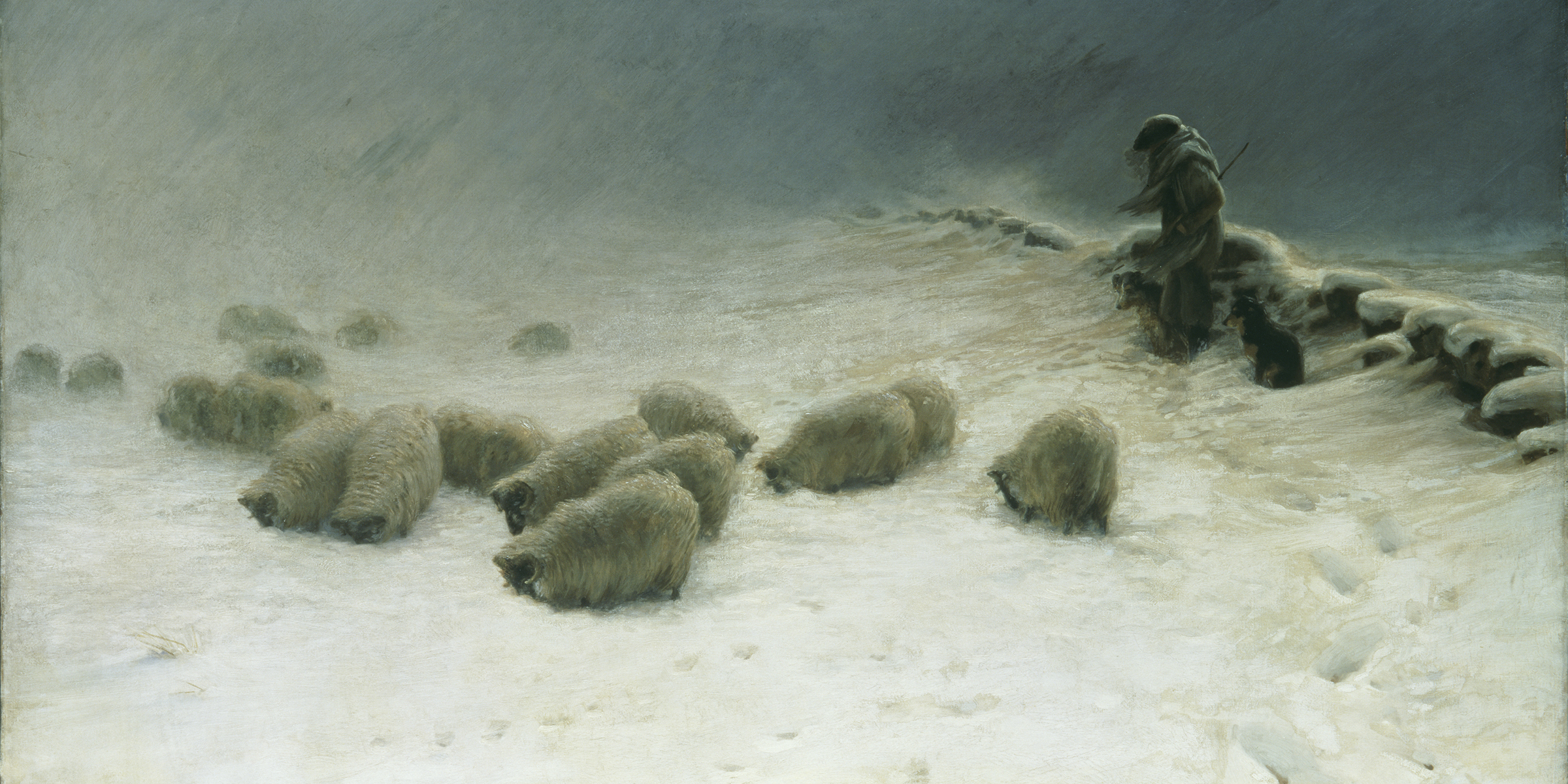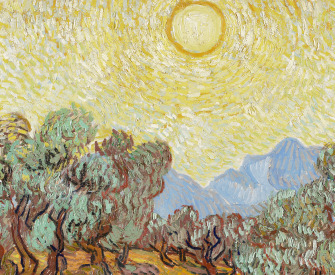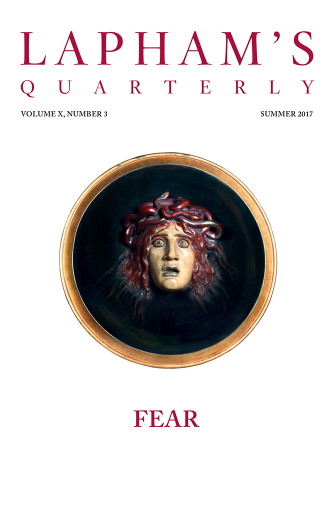We have forgotten how to be good guests, how to walk lightly on the earth as its other creatures do.
—Barbara Ward, 1972Paying the Piper
Acquiring an acquaintance with nature when capitalism has put its future at risk.
By Lewis H. Lapham

The Course of Empire: Destruction, by Thomas Cole, 1836. New-York Historical Society, Gift of The New York Gallery of the Fine Arts.
It is easier to imagine the end of the world than it is to imagine the end of capitalism.
—Fredric Jameson
The “control of nature” is a phrase conceived in arrogance, born of the Neanderthal age of biology and philosophy, when it was supposed that nature exists for the convenience of man.
—Rachel Carson
How is it that I have been able to exist for so long apart from nature, and without identifying myself with her?
—Gérard de Nerval
The warming of the planet currently spread across seven continents, four oceans, and twenty-four time zones is the product of a fossil-fueled capitalist economy that over the past two hundred years has stuffed the world with riches beyond the wit of man to marvel at or measure. The wealth of nations comes at a steep price—typhoons in the Philippine Sea, Category 5 hurricanes in the Caribbean, massive flooding in Kansas and Uttar Pradesh, forests disappearing in Sumatra and Brazil, unbearable heat in Paris, uncontrollable wildfires in California, unbreathable air in Mexico City and Beijing.
The capitalist dynamic is both cause of our prosperous good fortune and means of our probable destruction, the damage in large part the work of Adam Smith’s invisible hand, guided by the belief that money buys the future. Nature doesn’t take checks. Who then pays the piper—does capitalism survive climate change, or does a changed climate put an end to capitalism?
The question informs this issue of Lapham’s Quarterly, and in place of an answer, it offers observations that follow along the line of my learning to ask it. Eighty-five percent of the carbon now present in the atmosphere is the value added during the course of my lifetime, 2.5 trillion tons, roughly equivalent to one thousand times the total weight of all the fish in the sea. I was fifty years old before I knew it was there, much less understood it to be a problem.
Born and baptized in Rachel Carson’s Neanderthal age of biology and philosophy, I grew up in the city of San Francisco in the 1940s, so far apart from nature I assumed most of it located in Africa, picturesque specimens to be seen in Golden Gate Park and the San Francisco Zoo. The streets in my neighborhood bore the names of trees—Walnut and Cherry, Laurel, Chestnut, and Spruce. I didn’t wonder what the trees themselves might look like; nor was I familiar with the birds, plants, insects, and animals living on the far side of the Presidio wall, half a block from my boyhood home. Like most city-bred children of my generation (especially those among us brought up under the protection of money and machines), I thought bread came from the baker, light from a bulb, milk from a bottle. At grammar school during the Second World War, I devoted the free study periods to sketching the silhouette of every fighter plane and bomber in the American, German, and Japanese air forces.
When America emerged from the war in 1945 as the world’s supreme military and economic power, I was ten years old and sufficiently well versed in my grandmother’s readings from the Bible to associate the dropping of the atomic bomb on Hiroshima with God in the book of Genesis granting to mankind dominion over the beasts in the field, the birds in the air, and every creeping thing that creeps on the earth. Not only did nature exist for the convenience of man, man’s control of nature was absolute. Whatever was yet to be done in the name of peace, prosperity, and progress, nature henceforth had little say in the matter.
The degree of my ignorance conformed with the climate of victorious American opinion dominating not only Carson’s Neanderthal age but also what Aldous Huxley in 1956 named as the “most gilded golden age of human history—not only of past history but of future history.” The two authors refer to the same middle years of Life magazine’s American Century, but Huxley is trafficking in irony. His gilded golden age is the work of spendthrift heirs to the fortune that is nature’s gift to mankind in the form of “metallic ores and fossil fuels accumulated in the earth’s crust during hundreds of millions of years.” Let the profligate gold spoons persist in their extravagance, and Huxley figured that “within a few centuries or at most a few millennia” the human race must reduce itself to beggary or be remanded to oblivion.
The word to the wise appeared in the same year I was graduated from Yale College, urged by the commencement and prize-day orators to ignore it. The cap-and-gowned wisdom gathered under the elm trees on Old Campus assured the class of 1956 there would be no end to the wealth of its inheritance. The world was our oyster; go forth and partake in the feast of its consumption.
Huxley’s guess at how long the party would last was soon seen to be optimistic. In 1972 the voice of doom advertising itself as the Club of Rome (an ad hoc committee of internationally prominent scientists, economists, industrialists, and historians) issued a report, The Limits to Growth, that reduced good-time Charlie’s life expectancy to less than a hundred years. The committee had been set up in 1968 to address the specific problem of world food production and overpopulation (not enough of the former to feed the latter), but its findings broadened the reach of its concern:
If the present growth trends in world population, industrialization, pollution, food production, and resource depletion continue unchanged…the most probable result will be a rather sudden and uncontrollable decline in both population and industrial capacity.
In the context of the early 1970s, the report was both new and old news. For three thousand years, it had been well-known by observers with a mind to know it that wherever man plants his foot on the earth, he destroys the harmonies of nature. He had been doing so since he first began planting crops and husbanding animals, building cities and staking out empires.
Yuval Noah Harari, author of the best-selling 2014 history of mankind, Sapiens, rates Homo sapiens as “the deadliest species in the annals of planet Earth,” the historical record making him “look like an ecological serial killer.” Harari offers as case in point the settlement in Australia of the first hunter-gatherers crossing from Asia and climbing on arrival to the top of the food chain. Within the relatively brief span of a few thousand years, they permanently transformed the ecosystem. Of twenty-four animal species weighing a hundred pounds or more, twenty-three disappear, among them a marsupial lion, flightless birds twice the size of ostriches, and the giant diprotodon, a two-and-a-half-ton wombat.

Arlette, from the series No Man’s Land, by Henk van Rensbergen, 2016. © Henk van Rensbergen, courtesy the artist.
The Roman historian Tacitus places the same modus operandi in the hands of Domitian’s legions marching to conquer the far north of Britain in the year 83. The words for their enterprise Tacitus gives to the tribal chieftain Calgacus, rallying the indigenous barbarians against the threat of extinction. He says it’s no good trying to escape Rome’s arrogance by submission or good behavior. “They have pillaged the world…If an enemy is rich, they are greedy; if he is poor, they crave glory. Neither East nor West can sate their appetite…They plunder, they butcher, they ravish, and call it by the lying name of empire. They make a desert and call it peace.”
Times change, and so does the weather, but Homo sapiens in any and all climates remains steadfast in method and purpose. In 1864 the American naturalist
George Perkins Marsh draws the moral of the story then being told in the early years of the industrial revolution:
The destructive agency of man becomes more and more energetic and unsparing as he advances in civilization, until the impoverishment with which his exhaustion of the natural resources of the soil is threatening him…commences an almost indiscriminate warfare upon all the forms of animal and vegetable existence around him.
What was new in the Club of Rome’s report was the projected short period of time in which mankind was bound to accomplish its self-destruction. The resulting uproar in the popular press coincided with the growing public awareness of what was then coming to be known as “the environment.” The 1968 photograph Earthrise seen from Apollo 8 gave high-definition meaning to Alexander von Humboldt’s concept of the earth and all its creatures enveloped in a fragile membrane of unified being.
The fervent upwelling of the environmental movement in the mid-1970s also coincided with my becoming editor of Harper’s Magazine and therefore obliged to learn something about which I’d learned next to nothing during the long years of my thinking nature confined to quarters in a diorama. The publication’s back issues shed a first light in the darkness. Since its founding in 1850, Harper’s Magazine had devoted the greater part of its substance to reports and reflections on man’s relation with nature, and in lovingly preserved leather-bound volumes, I could read dispatches filed by Herman Melville, Mark Twain, John Muir, Teddy Roosevelt, and Bernard De Voto.
Staying on message during my thirty-year term as the magazine’s editor, I published the notes and observations of Loren Eiseley, Edward Abbey, Annie Dillard, Edward Hoagland, Louise Erdrich, and Barry Lopez, sent scouts to explore kingdoms of creation in the Canadian Arctic, the Galápagos Islands, the African jungle, and the Arabian desert. My acquiring an acquaintance with nature kept pace with the increasingly frequent sightings of environmental distress—more endangered species of fish, mammal, and bird; the Colorado River running out of water; toxic chemicals seeping into the soils of the Sacramento Valley; glaciers crumbling into the Weddell Sea; coral on Australia’s Great Barrier Reef fading to the palsied white of Melville’s Moby Dick.
Meanwhile and slowly, consulting sources scientific, philosophical, and poetic, I got to know myself as an organism, like every other organism in the cosmos, made from the wreckage of spent stars. Learning that I drew the breath of life not only from trees to which I hadn’t been introduced but also as a gift from unseen phytoplankton in the sea, I moved on to discover that with no more than a slight shifting of the astral dust of which I was composed, I might have ventured into the world as an eggplant or a killer whale. More likely the latter. Homo sapiens is born with the instincts of a Neolithic hunter-gatherer, no sating of his appetite east and west, no end north and south to his craving for riches and glory.
The capitalist dynamic is the craving for riches and glory in the hands of machines seen by
Karl Marx and Friedrich Engels in 1848 as the revolutionizing instruments of industrial production geared to “naked, shameless, direct, brutal exploitation,” and understood by Marsh to be waging “indiscriminate warfare upon all forms of animal and vegetable existence.” The carbon in the biosphere is the weapon of mass destruction.
It was recognized as such in 1988 by Dr. James Hansen, director of the NASA Goddard Institute for Space Studies, who testified before Congress about the accelerating rate of global warming, noting that “the greenhouse effect…may also have important implications other than for creature comfort.” How important the good doctor didn’t say. Not wishing to be seen as a spoilsport alerting the indigenous barbarians to their forthcoming extinction, he left it to other voices in other rooms to fill in the blanks and work out the details.
Their doing so provides many of the texts in this issue of Lapham’s Quarterly and shows them finding it easier to imagine the end of the world than to conceive of an end to capitalism. The journalist David Wallace-Wells, author of this year’s best-selling cry of alarm The Uninhabitable Earth, calls upon more than sixty expert witnesses (physicists and astrophysicists, biologists and microbiologists, climatologists, archaeologists, poets, and chemists) to identify Homo sapiens as a seriously endangered species. Let the carbon levels in the biosphere continue to rise at the current rate—and with them global temperatures warming by a few degrees Celsius—and the once-upon-a-time lord of the manor goes the way of the two-and-a-half-ton wombat.
Exactly how few degrees Celsius is a matter of conjecture, and Wallace-Wells is careful to say that the reading of numbers into the future, like the nightly news weather forecast, is not an exact science. The trend, however, is unmistakable; of the past five years, four have been the hottest on record in Europe, Asia, and the Americas.

The Joyless Winter Day (detail), by Joseph Farquharson, 1883. © Tate, London / Art Resource, NY.
Nor is climate change something new under the sun. The earth’s climate has been constantly changing for five billion years, passing through long ice ages and long ages of tropical wet, enduring short periods of environmental convulsion due to the tilt and spin of the earth’s orbit. Sixty-five million years ago, the beginnings of the Rocky Mountains were underwater; thirty thousand years ago, the Amazon jungle was dry savanna. The scene shifting was known to
Aristotle in 340 bc:
And if in places the sea recedes while in others it encroaches, then evidently the same parts of the earth as a whole are not always sea, nor always mainland, but in process of time all change.
Ancient Roman and Chinese sources attest to a darkening of the sun accompanied by crop failure that spread across half the globe in the 40s bc. The historian
Philipp Blom tells the story of the Little Ice Age dropping the temperature of Europe by up to two degrees Celsius in the seventeenth century and by so doing reconfiguring not only the climate but also the course of modern history.
Prior to the nineteenth century, the changes were the work of nature; they still are, but nature in its incarnation as man. Somewhere in the middle of the twentieth century, the planet with all its creatures moved out of the geological Holocene (the epoch into which I was born, together with the cherry tomato, the fox terrier, and the smallpox virus) and into the Anthropocene, so named in recognition of its having been formed in the carbon footprint of nature’s foremost ecological serial killer.
It isn’t the planet that’s at risk; the planet will continue to exist for another 7.5 billion years until the sun absorbs it. What’s at risk and in the throes of chaotic change is the biosphere, the stratum of cosmic organism encircling the globe (from a depth of six miles below sea level to a height of five miles above it), encompassing and networking all the forms and strands of life—forests and cities, begonias, centipedes, and trade unions—that we know collectively as “the world.”
The biosphere contains multitudes, but its resources are finite and cannot accommodate the pursuit of infinite growth that is the capitalist dynamic blowing up the hot-air balloon of the global consumer economy. Too many new people coming into the world (three billion in the years since Dr. Hansen testified before Congress) and not enough fresh water, fertile land, and clean air to provide them with the means of survival. The simple arithmetic accounts for the rapidly multiplying signs of environmental convulsion that float to the surface of the morning and evening news. The biosphere isn’t restricted to flora and fauna; it incorporates the fields and streams of human feeling, behavior, and thought. The ice melting in the Arctic and the sea levels rising on Miami and Malibu Beach (like the seventy million refugees these days everywhere in flight from disease, drought, and despotism, or the shrinking of vertebrate populations by an average of 60 percent since 1970) are aspects of climate change. So is the brutal and clownish incoherence of American politics in the age of Trump, British politics in the grip of Brexit, the flood tide of hatred and stupidity inundating America’s social media, the increasing number of shootings in America’s schools, twenty in the first six months of 2019.
Numerous authors in this issue of the Quarterly take note of the further correspondence between the human and geophysical kingdoms of creation. None do so more tellingly than
William Shakespeare. Everywhere in the plays, he builds bridges of metaphor across the biosphere’s myriad streams of consciousness—Hamlet’s melancholy situated in an unweeded garden, Lear’s madness in a raging storm, Ulysses in Troilus and Cressida speaking to the Greek army stranded on the beach at Troy, plagued by “shaking of earth, / commotion in the winds, frights, changes, horrors.”
The weather is an “evil mixture to disorder”; so is the temperament of the Greek captains and commanders who have been ten years below the walls of Troy, unable to behold the face that launched their thousand ships. Their “enterprise is sick.” Having lost sight of “the ladder of all high designs,” they fight among themselves on points of vanity of greed, turn to looting one another to sate their appetite for riches and glory.
Take but degree away, untune that string,
And hark what discord follows…
Then everything include itself in power,
Power into will, will into appetite;
And appetite, an universal wolf…
Must make perforce an universal prey
And last eat up himself.
The global consumer market is an universal wolf. Left to its Neolithic instincts, it must perforce eat up itself, devour and destroy the human race. Not with malice aforethought or for reasons ideological, but because it is a machine, and like all machines, among them the atomic bomb and Facebook, knows not what else to do.
Unfortunately for us all, neither do the profligate gold spoons who manage the world’s political and financial affairs. The instruments of “naked, shameless, direct, brutal exploitation” stuff with riches their corporations, banks, and party bags, and over the past fifty years, we have learned to accommodate ourselves to the climate of a world made by and for machines. Losing sight of ourselves as human beings, we look to machines to tell us who and why and what we are, what to do and where to go, what to eat and buy and think, when to cry, how and at whom to laugh.
We live in an age convinced that money buys the future, technology the salvation of the human race. The current episode of climate change is proving both assumptions wrong. The only power on earth capable of saving the human race is human, the means of doing so the learning that we are one with nature, not superior to or separate from.

This story is part of Covering Climate Now, a global collaboration of more than 300 news outlets to strengthen coverage of the climate story.


